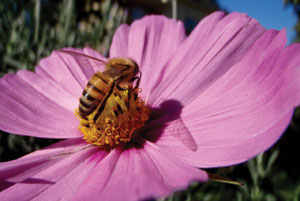New Film Looks For Answers to the Mystery of the Disappearing Honeybees and Searches For Solutions
We can thank humble honeybees for the bounty we enjoy. From cucumbers to coconuts, almonds to apples, flax to fennel along with numerous other food, oil and fabric crops (including cotton), our lives and fates are intertwined with those of the bee.
Bees are often overlooked, unless we’re ducking for cover, worried about being stung. Yet in recent years, they’ve been splashed across headlines as entire colonies of normally community-minded bees have unnaturally abandoned their queen and brood and mysteriously disappeared. To this day, the cause of the phenomenon termed Colony Collapse Disorder (CCD) is still largely unexplained. The mystery has sparked campaigns by beekeepers to save the bees and spurred on investigations by those concerned with both the bees and what they represent. Award-winning journalists and filmmakers George Langworthy and Maryam Henein (pictured below) are among those investigators and the two teamed up to codirect a film currently titled Return of the Honeybee.
When Langworthy heard about CCD, he was captivated. “A number of crucial big picture issues were wrapped up the story: agriculture, ecosystem ecology, politics, the economy and even spirituality.” He enlisted the help of Henein who believes, “Bees stand for the difference between life and death of our species and of our planet.” She was both entranced and disturbed by the deeper implications of the bees’ plight. “As a sister, it spoke to me; the bees abandoning their queen while we are abandoning Mother Earth…so I wanted to do something to be of service.”
When Langworthy heard about CCD, he was captivated. “A number of crucial big picture issues were wrapped up the story: agriculture, ecosystem ecology, politics, the economy and even spirituality.” He enlisted the help of Henein who believes, “Bees stand for the difference between life and death of our species and of our planet.” She was both entranced and disturbed by the deeper implications of the bees’ plight. “As a sister, it spoke to me; the bees abandoning their queen while we are abandoning Mother Earth…so I wanted to do something to be of service.”
Their service, along with the rest of the filmmaking crew, includes more than two years already spent following and filming beekeepers and bees, to uncover information about the past, present and future of honeybees. While it’s difficult to prove what’s been killing the bees, Langworthy says, “It’s obvious that bees have been exposed to great monocultures, to pesticides and fertilizers and they have often experienced a lack of nutrition.” Along with modern agricultural practices have come increasingly more lethal forms of pesticides, many of which, Henein and Langworthy point out, are systemic in nature, such as the newer and commonly used synthetic nicotine derivatives. These pesticides not only coat the seeds, but are taken up into the plant through its system of vessels, the xylem and phloem, to become part of the pollen.These insidious neurotoxins are taken back to the hive, stored and subsequently affect multiple generations of bees. Additionally, the Environmental Protection Agency (EPA) has not studied the possible synergistic effects of the different pesticides in combination, which is important because, according to Henein, “one single grain of pollen has proved to contain more than seventeen different chemicals.” And are pesticides adequately studied at all? As Langworthy was surprised to learn, the EPA itself doesn’t conduct any studies, but relies on toxicity data from the pesticide manufactures.
“Bees are great teachers and they have spoken,” according to Langworthy. Have we listened? The duo named the film Return of the Honeybees because they’re hopeful. They’ve seen initial steps toward a solution, including a rousing response from the general public related to the bees and a new willingness from the EPA and pesticide companies to actually enter into dialogues with beekeepers. In several European countries, beekeepers have been successful in getting specific pesticides taken off the market. Beekeepers are changing their practices to encourage survival of the hive, even in adverse conditions. Amateur beekeeping is on the rise with greater demand for courses on keeping a backyard hive. There’s even plans for keeping beehives in the Obama’s White House garden that’s just now breaking ground.
But before we rest on our laurels (or our pollen), Henein insists it’s up to us. “We can’t wait for the government or anyone else to change things in our agricultural landscape.” We all need to become advocates. Langworthy hopes the bees can inspire people to engage in better practices regarding pesticides, to plant bee-friendly gardens, grow organic fruits and vegetables and even keep bees. And most importantly of all, he hopes the bees teach us to recognize and act with an understanding of our interdependence.
A rough cut of Return of the Honeybees screened at the Environmental Film Festival and will be shown again at the Health Freedom Expo in Long Beach, April 4. The final cut of the film is currently being edited. The filmmakers have nonprofit status for their project and received a matching grant donation meaning any additional donations will be matched in kind. Visit their website for a regularly updated blog with information about the current state and the future of the honeybees: vanishingbees.com.
By Felicia M. Tomasko, RN


